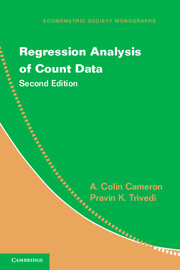Book contents
- Frontmatter
- Dedication
- Contents
- List of Figures
- List of Tables
- Preface
- Preface to the First Edition
- 1 Introduction
- 2 Model Specification and Estimation
- 3 Basic Count Regression
- 4 Generalized Count Regression
- 5 Model Evaluation and Testing
- 6 Empirical Illustrations
- 7 Time Series Data
- 8 Multivariate Data
- 9 Longitudinal Data
- 10 Endogenous Regressors and Selection
- 11 Flexible Methods for Counts
- 12 Bayesian Methods for Counts
- 13 Measurement Errors
- A Notation and Acronyms
- B Functions, Distributions, and Moments
- C Software
- References
- Author Index
- Subject Index
- Miscellaneous Endmatter
9 - Longitudinal Data
Published online by Cambridge University Press: 05 July 2014
- Frontmatter
- Dedication
- Contents
- List of Figures
- List of Tables
- Preface
- Preface to the First Edition
- 1 Introduction
- 2 Model Specification and Estimation
- 3 Basic Count Regression
- 4 Generalized Count Regression
- 5 Model Evaluation and Testing
- 6 Empirical Illustrations
- 7 Time Series Data
- 8 Multivariate Data
- 9 Longitudinal Data
- 10 Endogenous Regressors and Selection
- 11 Flexible Methods for Counts
- 12 Bayesian Methods for Counts
- 13 Measurement Errors
- A Notation and Acronyms
- B Functions, Distributions, and Moments
- C Software
- References
- Author Index
- Subject Index
- Miscellaneous Endmatter
Summary
INTRODUCTION
Longitudinal data or panel data are observations on a cross-section of individual units such as persons, households, firms, and regions that are observed over several time periods. The data structure is similar to that of multivariate data considered in Chapter 8. Analysis is simpler than for multivariate data because for each individual unit the same outcome variable is observed, rather than several different outcome variables. Yet analysis is also more complex because this same outcome variable is observed at different points in time, introducing times series data considerations presented in Chapter 7.
In this chapter we consider longitudinal data analysis if the dependent variable is a count variable. Remarkably, many count regression applications are to longitudinal data rather than simpler cross-section data. Econometrics examples include the number of patents awarded to each of many individual firms over several years, the number of accidents in each of several regions, and the number of days of absence for each of many persons over several years. A political science example is the number of protests in each of several different countries over many years. A biological and health science example is the number of occurrences of a specific health event, such as a seizure, for each of many patients in each of several time periods.
- Type
- Chapter
- Information
- Regression Analysis of Count Data , pp. 341 - 384Publisher: Cambridge University PressPrint publication year: 2013
- 2
- Cited by

